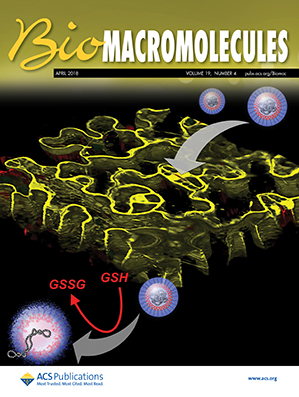pH和超声响应聚合物胶束的制备:不同亲疏水嵌段比的两亲嵌段共聚物对自组装和药物控释的影响。
IF 5.4
2区 化学
Q1 BIOCHEMISTRY & MOLECULAR BIOLOGY
引用次数: 0
摘要
当暴露于内部或外部触发时,刺激响应聚合物载体可以改变其物理或化学性质,从而实现对药物释放的精确时空控制。然而,制备具有不同亲疏水嵌段比的双刺激响应型两亲嵌段共聚物形成自组装结构的系统研究尚缺乏。在这里,我们合成了两种类型的嵌段共聚物,由疏水段(即ph响应的2-(二乙胺)甲基丙烯酸乙酯(DEA)和超声响应的2-甲氧基甲基丙烯酸乙酯(MEMA))和亲水的聚乙二醇甲基醚(mPEG)段组成,形成了mPEGX-b-P(DEAY-co-MEMAZ)。这些两亲性嵌段共聚物可以自组装形成聚合物胶束,并对其结构(如尺寸)和性能(如临界囊泡浓度、稳定性、对pH和超声的刺激反应性、载药效率和控释药物性能)进行了深入研究。体外细胞研究进一步证明,超声波可以有效地触发聚合物胶束的药物释放,强调了它们在治疗应用中控制药物递送的潜力。本文章由计算机程序翻译,如有差异,请以英文原文为准。
Fabrication of pH- and Ultrasound-Responsive Polymeric Micelles: The Effect of Amphiphilic Block Copolymers with Different Hydrophilic/Hydrophobic Block Ratios for Self-Assembly and Controlled Drug Release
Stimuli-responsive polymeric vehicles can change their physical or chemical properties when exposed to internal or external triggers, enabling precise spatiotemporal control of drug release. Nevertheless, systematic research is lacking in preparing dual stimuli-responsive amphiphilic block copolymers with different hydrophilic/hydrophobic block ratios in forming self-assembled structures. Here, we synthesized two types of block copolymers consisting of the hydrophobic segments (i.e., pH-responsive 2-(diethylamino)ethyl methacrylate (DEA) and ultrasound-responsive 2-methoxyethyl methacrylate (MEMA)) and hydrophilic poly(ethylene glycol) methyl ether (mPEG) segments, forming mPEGX-b-P(DEAY-co-MEMAZ). These amphiphilic block copolymers can self-assemble to form polymeric micelles, and their structures (e.g., size) and properties (e.g., critical vesicle concentration, stability, stimuli-responsiveness to pH and ultrasound, drug loading efficiency, and controlled drug release performance) were thoroughly investigated. In vitro cell studies further demonstrate that ultrasound can efficiently trigger drug release from polymeric micelles, emphasizing their potential for controlled drug delivery in therapeutic applications.
- Download: Download high-res image (158KB)
- Download: Download full-size image
求助全文
通过发布文献求助,成功后即可免费获取论文全文。
去求助
来源期刊

Biomacromolecules
化学-高分子科学
CiteScore
10.60
自引率
4.80%
发文量
417
审稿时长
1.6 months
期刊介绍:
Biomacromolecules is a leading forum for the dissemination of cutting-edge research at the interface of polymer science and biology. Submissions to Biomacromolecules should contain strong elements of innovation in terms of macromolecular design, synthesis and characterization, or in the application of polymer materials to biology and medicine.
Topics covered by Biomacromolecules include, but are not exclusively limited to: sustainable polymers, polymers based on natural and renewable resources, degradable polymers, polymer conjugates, polymeric drugs, polymers in biocatalysis, biomacromolecular assembly, biomimetic polymers, polymer-biomineral hybrids, biomimetic-polymer processing, polymer recycling, bioactive polymer surfaces, original polymer design for biomedical applications such as immunotherapy, drug delivery, gene delivery, antimicrobial applications, diagnostic imaging and biosensing, polymers in tissue engineering and regenerative medicine, polymeric scaffolds and hydrogels for cell culture and delivery.
 求助内容:
求助内容: 应助结果提醒方式:
应助结果提醒方式:


